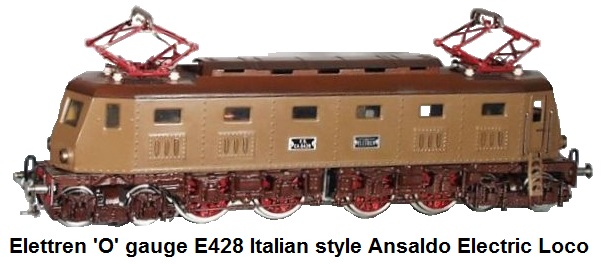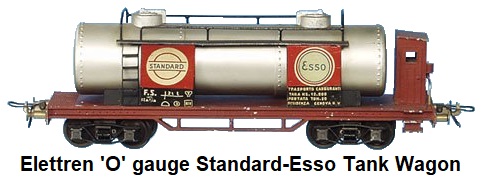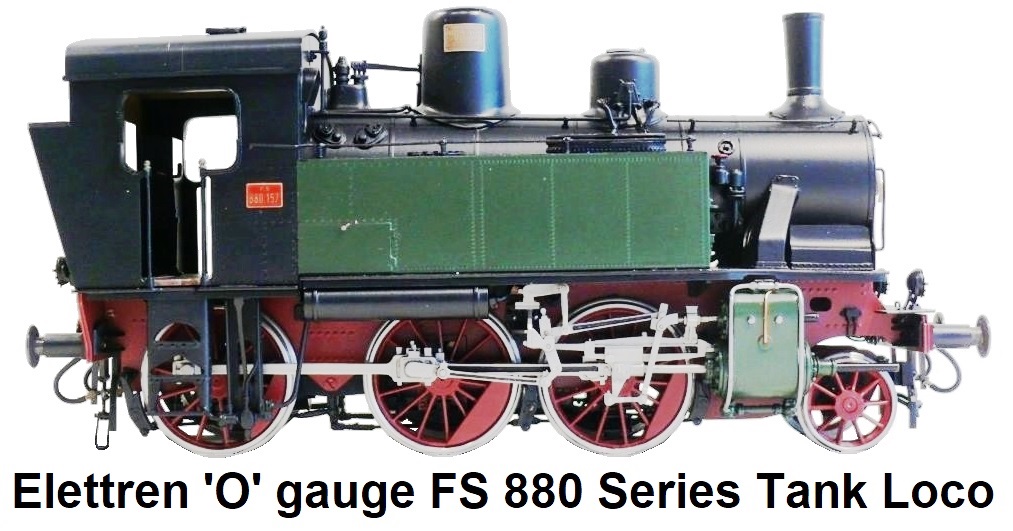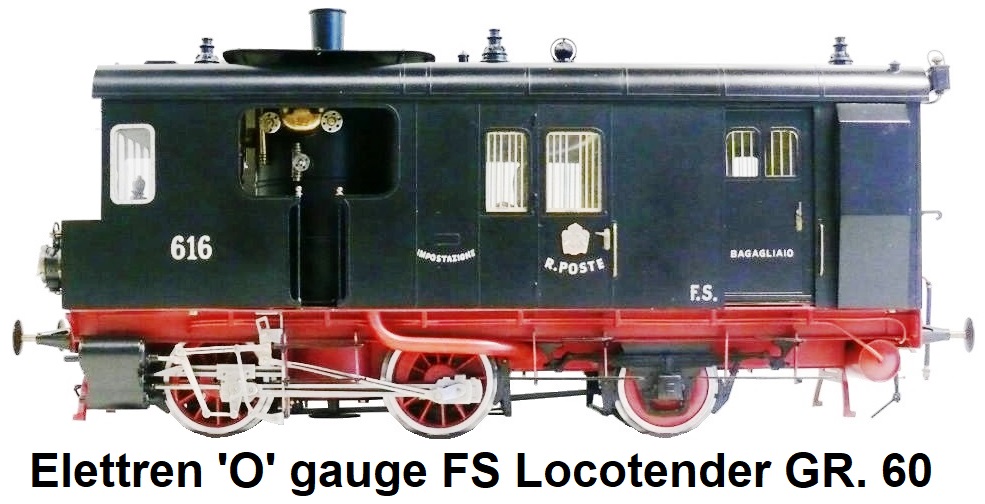History
 Elettren was founded by Armando Ravasini in Milan Italy in 1946. Armando Ravasini had been an engineer working for
Pirelli, the famous tire manufacturers. Elettren (which stands for 'electric train') started out manufacturing
high-quality finely detailed tinplate model locomotives and passenger cars in 'O' gauge to compete with the likes of
Märklin. Elettren is still in business today, specializing in the manufacture of finescale
brass 1:43.5 models (32 mm track width) utilizing a variety of modern techniques including acid etching and lasercutting.
Fulgurex, a Swiss premium model train manufacturer was started in 1947 to handle distribution of Elettren designed trains.
Elettren was founded by Armando Ravasini in Milan Italy in 1946. Armando Ravasini had been an engineer working for
Pirelli, the famous tire manufacturers. Elettren (which stands for 'electric train') started out manufacturing
high-quality finely detailed tinplate model locomotives and passenger cars in 'O' gauge to compete with the likes of
Märklin. Elettren is still in business today, specializing in the manufacture of finescale
brass 1:43.5 models (32 mm track width) utilizing a variety of modern techniques including acid etching and lasercutting.
Fulgurex, a Swiss premium model train manufacturer was started in 1947 to handle distribution of Elettren designed trains.
 Elettren trains are known for their precision and fidelity to their prototypes. The first Elettren powered models produced
were the FS 691 Pacific class steam locomotive and the E428 Italian style Ansaldo 2-B-B-2 heavy electric. It was the
original model of the Italian class E428 that caught the eye of Count Antonio Giansanti Coluzzi, when it was on display at
the Noë shop in Milan. Giansanti Coluzzi arranged to meet Mr. Ravasini and agreed to have 50 of the models constructed.
The result was Fulgurex. Elettren also produced a line of tinplate passenger coaches
and goods wagons.
Elettren trains are known for their precision and fidelity to their prototypes. The first Elettren powered models produced
were the FS 691 Pacific class steam locomotive and the E428 Italian style Ansaldo 2-B-B-2 heavy electric. It was the
original model of the Italian class E428 that caught the eye of Count Antonio Giansanti Coluzzi, when it was on display at
the Noë shop in Milan. Giansanti Coluzzi arranged to meet Mr. Ravasini and agreed to have 50 of the models constructed.
The result was Fulgurex. Elettren also produced a line of tinplate passenger coaches
and goods wagons.
Count Antonio Giansanti Coluzzi (1915-2006), was also of Italian descent, and was the founder and
President of Rextoys. Rextoys made a range of vintage 1:43 scale vehicles in various liveries, including some that were
military related. The Count fell in love with trains in 1923, when, as an 8 year old wintering with his parents at
Cap d'Ail on the Cote d'Azur, he would  watch the Blue Train on its daily run from Paris to Ventimiglia. As he grew older he got to know the master artisans
of toy-train making - he would call them artists, even folk artists - tucked away in various corners of Europe and,
after World War II, of Japan. Eventually, in 1946, he would found Fulgurex (Fulgur x Rex -''The king of the lightning
flash''), an enterprise designed specifically to produce and distribute the finest model trains for the
most demanding of those obsessed with miniaturization including the distribution of Elettren trains.
The Count was also the author of a coffee table picture book on trains, "The Trains on Avenue De Rumine". This
work includes four and a half pages of pictures and text illustrating several Elettren locomotives, passenger, and
freight wagons made through 1980.
watch the Blue Train on its daily run from Paris to Ventimiglia. As he grew older he got to know the master artisans
of toy-train making - he would call them artists, even folk artists - tucked away in various corners of Europe and,
after World War II, of Japan. Eventually, in 1946, he would found Fulgurex (Fulgur x Rex -''The king of the lightning
flash''), an enterprise designed specifically to produce and distribute the finest model trains for the
most demanding of those obsessed with miniaturization including the distribution of Elettren trains.
The Count was also the author of a coffee table picture book on trains, "The Trains on Avenue De Rumine". This
work includes four and a half pages of pictures and text illustrating several Elettren locomotives, passenger, and
freight wagons made through 1980.
The Elettren model of the Italian FS Ansaldo 2-B-B-2 E428 locomotive is large and heavy. Over the
years Elettren has produced this loco in several European liveries and with one or two motors. These streamlined
electric locomotive models can still be custom ordered. Ansaldo was one of Italy's oldest and most important engineering
companies, existing for 140 years from 1853 to 1993. They introduced the E428 prototype in 1934 to be used for fast services
on the Florence–Rome railway. They were decommissioned in the 1980's. These locomotives were considered
to be very impressive for their size, power and speed, with abilites to reach 130 to 150 km/h.

Armando Ravasini's second locomotive, the Italian 4-6-2 Pacific type steam locomotive class FS 691,
is considered by collectors and hobbyists to be a key milestone in the transition from toy-like models to more scale-like
models as the locomotive represented a significant step up in the detail that was applied. Measuring over 23 inches
combined length, both the loco & tender are made of heavy gauge steel and diecast metal. The Elettren locomotive
incorporated a large number of metal castings such as the Westinghouse type steam pump (used for simulating the compressed
air brake system) on the front of the locomotive. The backhead features pressure gauges, valves, and firebox doors that
open and close in the
 engineer's cab. Also featured are illuminated front and rear lamps, and under-frame details that match its prototype,
achieving a level of detail not previously seen on ready-to-run tinplate locomotives. Over the years Elettren has
continued to improve and embellish this loco with even greater detail, and has added a directional lighting function
as well as operating smoke. The smoke device consisted of a heating element and a pump driven by a cam on the first drive
shaft with a connecting rod. Originally built in
the 1920's, the prototype Class 691 4-6-2 Pacific's were the fastest and most powerful locomotives ever built for the
Italian railways. They served on the Milan-Bologna route (up to 1938, when the line was electrified) and the Milan-Venice
mainlines throughout their careers, pulling the heaviest and fastest express trains. A 691 scored the speed record between
the Verona and Padova stations for a steam engine at 150 km/h. Of the 33 locomotives that were created (rebuilt from Class
690's) only one 691 locomotive survived into preservation, the 691.022, which is a static exhibit at the Museo della
Scienza e della Tecnologia "Leonardo da Vinci" in Milan, Italy. In addition to the Pacific FS 691, Elettren also produced
a 2-8-2 Mikado, the FS 746 class locomotive which was very similar in appearance to the Pacific. All the early Elettren
locomotives were initially 3-rail DC powered, however a change to support operation on AC power eventually took place around
1956. In the Elettren 1964 catalog there is a note stating that when ordering locomotives, it should be specified whether
an AC or DC version is being requested. The Elettren locos were also fitted with a reversing mechanism relay that operated
by receiving DC pulses sent from a button on the transformer to the track rails. Over time, changes were made to the 691
cab roofs. Newer models were fitted with composite roofs, while the older original models were fitted with all metal
roofs.
engineer's cab. Also featured are illuminated front and rear lamps, and under-frame details that match its prototype,
achieving a level of detail not previously seen on ready-to-run tinplate locomotives. Over the years Elettren has
continued to improve and embellish this loco with even greater detail, and has added a directional lighting function
as well as operating smoke. The smoke device consisted of a heating element and a pump driven by a cam on the first drive
shaft with a connecting rod. Originally built in
the 1920's, the prototype Class 691 4-6-2 Pacific's were the fastest and most powerful locomotives ever built for the
Italian railways. They served on the Milan-Bologna route (up to 1938, when the line was electrified) and the Milan-Venice
mainlines throughout their careers, pulling the heaviest and fastest express trains. A 691 scored the speed record between
the Verona and Padova stations for a steam engine at 150 km/h. Of the 33 locomotives that were created (rebuilt from Class
690's) only one 691 locomotive survived into preservation, the 691.022, which is a static exhibit at the Museo della
Scienza e della Tecnologia "Leonardo da Vinci" in Milan, Italy. In addition to the Pacific FS 691, Elettren also produced
a 2-8-2 Mikado, the FS 746 class locomotive which was very similar in appearance to the Pacific. All the early Elettren
locomotives were initially 3-rail DC powered, however a change to support operation on AC power eventually took place around
1956. In the Elettren 1964 catalog there is a note stating that when ordering locomotives, it should be specified whether
an AC or DC version is being requested. The Elettren locos were also fitted with a reversing mechanism relay that operated
by receiving DC pulses sent from a button on the transformer to the track rails. Over time, changes were made to the 691
cab roofs. Newer models were fitted with composite roofs, while the older original models were fitted with all metal
roofs.
In 1964 Franco Ravasini replaced his Father Armando as head of Elettren. At that time, Franco expanded
the range of products, creating both tinplate and scale passenger cars. Cars were made of metal and featured interior
lighting, working doors, full interiors with corridors and compartments, and working diaphragms. These coaches were mostly
replicas of the famous Grands Express Européens carriages that Compagnie Internationale des Wagons-Lits (CIWL)
employed for the Orient Express train.
While Elettren concentrated its efforts on an assortment of passenger coaches, they did produce a few
freight wagons. All the freight wagons were in 'O' scale with four or six axles and employed both stamped sheet
 metal and diecast construction but detail was an important feature of these wagons as well. The Elettren freight wagons,
none of which are produced today, consisted of 5 different 4-axle tank wagons (Shell, BP, Esso, Standard, & Standard-Esso),
a 4-axle open goods wagon, a 4-axle flat wagon with stanchions, a 6-axle stake wagon with stanchions, a 4-axle flat wagon
with 3 cable reels, and 2 different 6-axle transformer wagons. The 6-axle transformer wagons (originally produced in
green and subsequently in brown liveries) are unique models in the world of toy trains representing mobile power substations
used by the Italian State Railways for work on their electrified system. The cars featured insulators, radiators,
transformers, and personnel cabins.
metal and diecast construction but detail was an important feature of these wagons as well. The Elettren freight wagons,
none of which are produced today, consisted of 5 different 4-axle tank wagons (Shell, BP, Esso, Standard, & Standard-Esso),
a 4-axle open goods wagon, a 4-axle flat wagon with stanchions, a 6-axle stake wagon with stanchions, a 4-axle flat wagon
with 3 cable reels, and 2 different 6-axle transformer wagons. The 6-axle transformer wagons (originally produced in
green and subsequently in brown liveries) are unique models in the world of toy trains representing mobile power substations
used by the Italian State Railways for work on their electrified system. The cars featured insulators, radiators,
transformers, and personnel cabins.
In 1993 Fabio and Maurizio Ravasini continued the family tradition, becoming the 3rd generation to lead
the firm. They started a new age for the company - characterized by the production of new top quality models made with the
best handicraft techniques - though keeping the 60 years of Elettren's style unchanged. Reflecting changes in the European
market, the grandsons of Armando Ravasini moved to fine scale reproduction of European passenger cars of FS, SBB CFF, PLM,
CIWL, DB, DSG, and other prototypes. (Lemaco’s fine scale Swiss coaches were made by Elettren.) All equipment is made of
brass and other
 ferrous metal trimmed and drawn plates with heavy reliance on photo etching and lost wax castings. Inscriptions and livery
are accomplished with pad printing and silkscreen processes. Elettren passenger coaches have removable roofs and are
elaborate in the included interior and exterior detail. All trains are equipped with interior electric lighting, doors that
are spring loaded to open and close, locking corridor connections, cloth gangways, end fall plates, upholstered furniture,
cloth bedding and pillows on beds in sleeping coaches, bar and refreshment facilities in saloon coaches and cooking gear
in kitchens of dining cars. Because of the high quality construction and attention to detail of these models, they are long
lasting and tend to be well preserved by their owners. These products would not be considered to be or should not be referred
to as toy trains, as they are fully functional scale models of, and are identical to the original prototypes in every detail.
These products are coveted by competent collectors worldwide. Coaches have sold on eBay for more than $1000 each.
ferrous metal trimmed and drawn plates with heavy reliance on photo etching and lost wax castings. Inscriptions and livery
are accomplished with pad printing and silkscreen processes. Elettren passenger coaches have removable roofs and are
elaborate in the included interior and exterior detail. All trains are equipped with interior electric lighting, doors that
are spring loaded to open and close, locking corridor connections, cloth gangways, end fall plates, upholstered furniture,
cloth bedding and pillows on beds in sleeping coaches, bar and refreshment facilities in saloon coaches and cooking gear
in kitchens of dining cars. Because of the high quality construction and attention to detail of these models, they are long
lasting and tend to be well preserved by their owners. These products would not be considered to be or should not be referred
to as toy trains, as they are fully functional scale models of, and are identical to the original prototypes in every detail.
These products are coveted by competent collectors worldwide. Coaches have sold on eBay for more than $1000 each.
Elettren 'O' gauge Compagnie des chemins de fer de Paris à Lyon et à la Méditerranée (PLM) Coaches




Recent additions to the Elettren line include a 1:43.5 scale reproduction model of the Ferrovie
dello Stato Italiane (FS; Italian State Railways) 880 group tank locomotive, and the FS Locotender railcar Gr. 60.
Both of these are made for 2-rail operation. The FS 880 model was constructed entirely of brass using various
techniques including lost wax casting, chemical
 turning and laser cutting. The loco was fitted with a Faulhaber 12 volt DC power plant. It was adorned with operating
headlights, as well as smoke chamber door, water tank hatches and sunroof that open and close. The bumpers and frame
were fully sprung. The cabin roof and interior were made of wood. The wheel rims were stainless steel. The FS 880
locomotive prototypes were built between 1916 and 1922. Designed for secondary lines, they operated all over
the Italian peninsula on flat lines pulling passenger trains and goods with a modest number of wagons. The last
continuous use of this locomotive is dated to 1978. Today some specimens of this coal burner survive in museums and
private collections.
turning and laser cutting. The loco was fitted with a Faulhaber 12 volt DC power plant. It was adorned with operating
headlights, as well as smoke chamber door, water tank hatches and sunroof that open and close. The bumpers and frame
were fully sprung. The cabin roof and interior were made of wood. The wheel rims were stainless steel. The FS 880
locomotive prototypes were built between 1916 and 1922. Designed for secondary lines, they operated all over
the Italian peninsula on flat lines pulling passenger trains and goods with a modest number of wagons. The last
continuous use of this locomotive is dated to 1978. Today some specimens of this coal burner survive in museums and
private collections.
 Elettren's FS GR. 60 is based on steam rail cars that were acquired in Italy from 1905 to 1907 from several
different builders, including Maffei, Austro Hungarian Co., the Belgian Co., Borsig and Ringhoffer. These locmotives
featured vertical boilers. In the first years of life, the Gr. 60 served in numerous towns in the plains of northern
Italy to tow light trains. These railcars could only attain a maximum speed of 60 km/h, which limited their towing
capacity, and resulted in a short life span. Many were repurposed as locomotives. Elettren's model was designed with
a luggage compartment and post office similar to the Borsig version.
Elettren's FS GR. 60 is based on steam rail cars that were acquired in Italy from 1905 to 1907 from several
different builders, including Maffei, Austro Hungarian Co., the Belgian Co., Borsig and Ringhoffer. These locmotives
featured vertical boilers. In the first years of life, the Gr. 60 served in numerous towns in the plains of northern
Italy to tow light trains. These railcars could only attain a maximum speed of 60 km/h, which limited their towing
capacity, and resulted in a short life span. Many were repurposed as locomotives. Elettren's model was designed with
a luggage compartment and post office similar to the Borsig version.
Elettren 'O' gauge Compagnie Internationale des Wagons-Lits (CIWL) Grands Express Européens carriages




Elettren has no US distribution, but it sells its current line of products both to retail stores
and individuals. Ordering can be done direct. They make their products in small batches of 20 models per year.
While the majority of their competition have moved production facilities to Korea or China where labor is cheap,
Elettren construction is still done entirely in Italy with a total staff of only four. Elettren offers large wheel
flanges on their products as an option for those with tinplate 'O' gauge trains and layouts. The making of Elettren
trains can truely be considered an art form. Since these models were hand made in limited numbers, the older original
Elettren locomotives - the 691 and E428 - are highly sought after by collectors and sell in the $2,000 to $10,000 range,
when they can be found for sale, usually in auctions of private collections. Unfortunately, since these locomotive models
were mostly made of die-cast parts, many have suffered from metal fatigue and zincpest, so it is even more difficult to
find them in pristine condition.


Link to Elettren web site.
